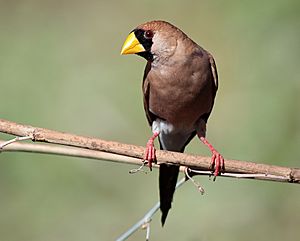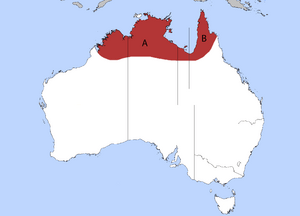Masked finch facts for kids
Quick facts for kids Masked finch |
|
|---|---|
 |
|
| Gregory River, Queensland, Australia | |
| Conservation status | |
| Scientific classification | |
 |
|
| Distribution A = race peronata B = race leucotis |
The masked finch (Poephila personata) is a small passerine bird. It belongs to the estrildid finch family, called Estrildidae. This bird is commonly found in the dry savannah areas of northern Australia. You can see them from the Kimberley region, across the Top End, the Gulf country, and the southern part of Cape York Peninsula. They live as far east as Chillagoe, but always close to water.
Contents
What Does a Masked Finch Look Like?
The masked finch is a small bird, about 12.5 to 13.5 centimeters long. That's about the length of your hand! Male birds are a bit bigger than females, but they look very similar.
Their back and upper parts are a warm cinnamon-brown color. Their belly is lighter. They have a white patch on their rump, which is the area just above their tail. A black mark can be seen on their sides. The most striking feature is their black face, which looks like a mask!
They have a strong, yellow beak and a pointy black tail. There's a special type of masked finch in the eastern parts of Australia, called P. p. leucotis. This type has whitish cheeks instead of just black.
How Do Masked Finches Behave?
Masked finches usually search for food in pairs or small groups. They spend most of the day on the ground, looking for grass seeds that have fallen.
In the evenings and early mornings, many masked finches gather around waterholes. Sometimes thousands of them come together! They drink water, take baths, and clean their feathers. While doing this, they often flick their tails from side to side and make lots of chattering sounds.
Nesting and Reproduction
Masked finch pairs build their nests during the late wet season or early dry season. They create a dome-shaped nest using grasses. Inside, they line it with fine grass, soft feathers, and even charcoal.
The location of their nest can vary a lot. Some nests are built high up, as much as 20 meters off the ground. Others are simply hidden in tall grass. Female masked finches usually lay five to six white eggs.
Where Did Masked Finches Come From?
Scientists have studied the origin and family tree (called phylogeny) of these birds. It's thought that the Estrildinae family, which includes the masked finch, might have first appeared in India. From there, they spread out to places like Africa and islands in the Pacific Ocean.
Images for kids
See also
 In Spanish: Diamante enmascarado para niños
In Spanish: Diamante enmascarado para niños




